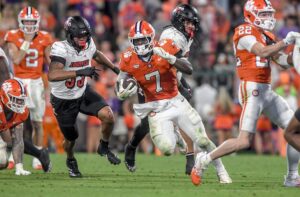The West Virginia Mountaineers kicked off their matchup in Texas riding a 4-2 record. Coming off of a big win against Kansas State, West Virginia looked to build on that momentum. While we hate to blame officials for the outcome of games, sometimes, the shoe fits. Two questionable calls (or a no-call, in one instance) cost West Virginia a close win against Texas. As such, the theme here is clear: The Mountaineers were robbed in Austin.
Robbed in Austin
It is not often that a renowned physicist offers opinions on a midday college football game. But that is exactly what happened at the end of the third quarter. On the field, the referees ruled that Alonzo Addae recovered a fumble on a backward pass from Sam Ehlinger. See the play here.
I have it as a backward pass and fumble…@neiltyson
Did you have something to do with this call being overturned? Can I get a ruling on this?@PardonMyTake @PFTCommenter @BarstoolBigCat pic.twitter.com/nuGuF2Pk20
— Travis (@tw_cunningham) November 7, 2020
In fact, even famed physicist Neil deGrasse Tyson confirmed the accuracy of the ruling on the field that Ehlinger made a backward pass.
A backward pass in their moving coordinate system. Formally, it’s a “Galilean Transformation” in which the running back was behind the QB at all times during the pass and catch.
Fully legit in the world of physics.
— Neil deGrasse Tyson (@neiltyson) November 7, 2020
The referees, however, reversed the call. As a result, a fumble recovery inside the Longhorns’ 40 was erased.
Then, in the final minutes of the game, Head Coach Neal Brown dialed up a run-pass option on fourth and one. Quarterback Jarret Doege pulled the handoff from Leddie Brown and tossed the ball into the middle of the end zone, looking to find Ali Jennings for a score. But Longhorn safety Chris Brown yanks Jennings to the ground before the ball arrived. The interference was obvious, yet the referees withheld their flags, costing the Mountaineers a would-be go-ahead touchdown with minutes left to play.
Bad Coaching Decisions?
Even without the calls, West Virginia fans questioned the decision by Brown, on two straights drives, to go for it on fourth and one inside the ten. On each play, Doege had receivers in position for a score. On the first series, Doege threw a ball a fraction of a second too late, and Mike O’Laughlin was unable to haul in the catch through contact in the corner of the end zone. Had Brown sent Casey Legg out, fans argued, West Virginia would be down only one point.
Of course, we do not know what happens on the ensuing drive if the Mountaineers kick, and the Longhorns assume a better starting field position. Do they have the same opportunity to march on the ensuing offensive possession? We do not know. Nonetheless, the West Virginia defense held firm on Texas’ next drive, getting the ball back to offense quickly.
Then on that following drive, West Virginia marched down the field and found itself in the red zone, again facing a fourth-and-one decision. At this point, with just over two minutes left in the game, Brown had no choice but to go for it. But if West Virginia was only down 17-16, maybe that second field goal gives the Mountaineers a 19-17 lead. Texas, of course, has a pretty good kicker, too. So a 19-17 lead may not have been enough.
Given the data on these situations, it is hard to argue with the decision-making. Coach Brown certainly did not apologize for the decisions after the game. Indeed, he defended them based on the data saying teams have to score touchdowns to win in the Big 12.
Defense Maintains Reputation
Regardless of any offensive decision-making or weaknesses (and there are a few weaknesses for sure), the West Virginia defense maintained its reputation as a top-tier unit. While the numbers support the claim, the criticism was this: West Virginia had not yet faced a top-tier offense. As a result, many wondered what would happen when the best defense in the Big 12 faced its best offense.
Indeed, going into the game, the Longhorns averaged 450 yards and 44 points per game. Despite the high-octane offense, West Virginia stood firm. They only surrendered 17 points on 363 yards, both well below the Longhorn averages.
As they usually do, the defense adjusted quickly after a slow start. On the opening drive, West Virginia gave up a big run to Bijan Robinson–who will be a problem for the next several years for opposing defenses–and Texas capped the drive off with a touchdown. After the first 75-yard drive, though, the Mountaineers only gave up 10 points and 288 yards.
West Virginia Heading Back Home
Next week, West Virginia is back home to host TCU in Morgantown. After the Mountaineers were robbed in Austin, they will certainly look to bounce back and claim their fifth win of the season.






